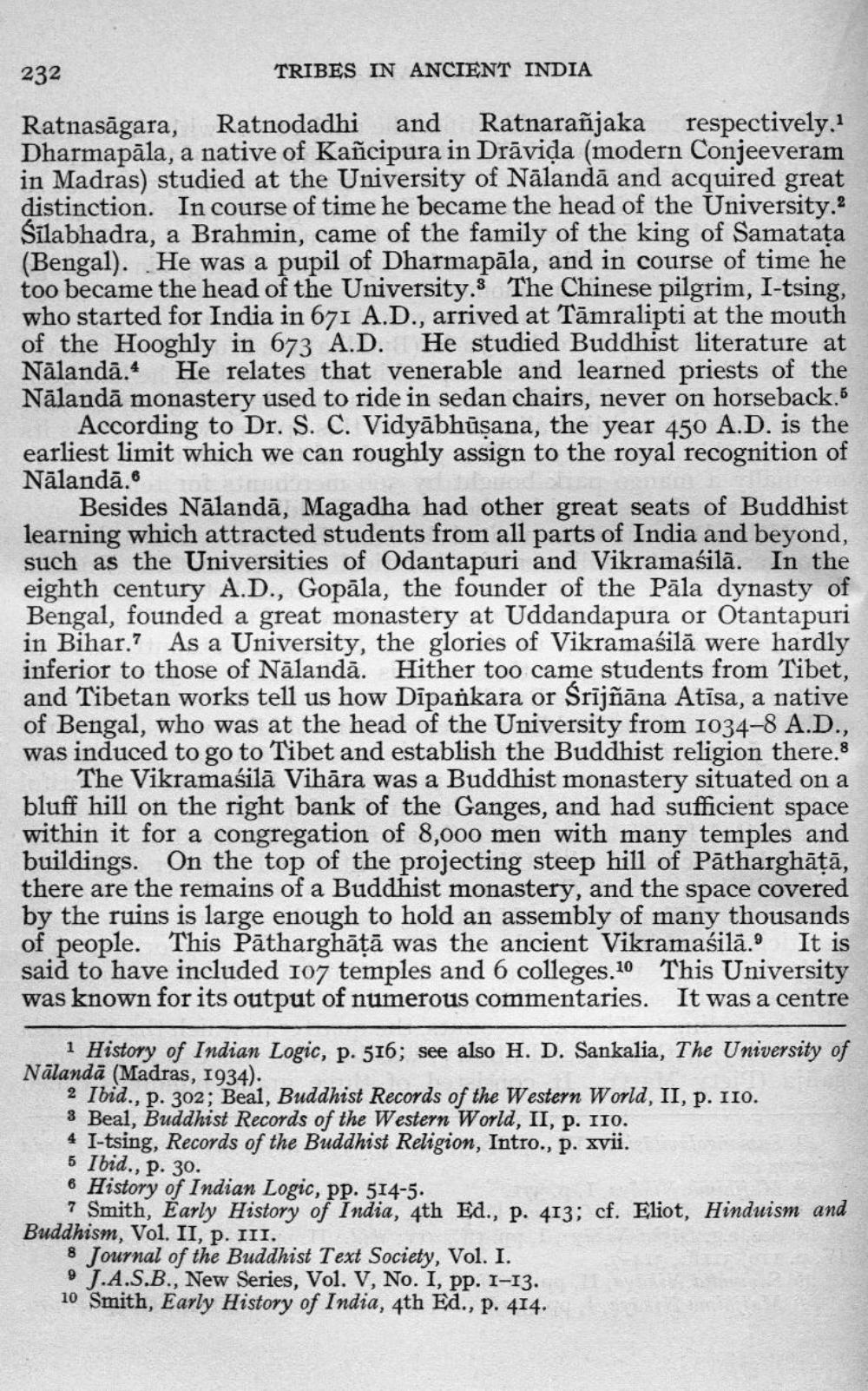________________
232
TRIBES IN ANCIENT INDIA Ratnasāgara, Ratnodadhi and Ratnarañjaka respectively.1 Dharmapāla, a native of Kañcipura in Drāvida (modern Conjeeveram in Madras) studied at the University of Nālandā and acquired great distinction. In course of time he became the head of the University.2 Śīlabhadra, a Brahmin, came of the family of the king of Samatata (Bengal). He was a pupil of Dharmapāla, and in course of time he too became the head of the University.3 The Chinese pilgrim, I-tsing, who started for India in 671 A.D., arrived at Tāmralipti at the mouth of the Hooghly in 673 A.D. He studied Buddhist literature at Nālandā. He relates that venerable and learned priests of the Nālandā monastery used to ride in sedan chairs, never on horseback. 5
According to Dr. S. C. Vidyābhūsana, the year 450 A.D. is the earliest limit which we can roughly assign to the royal recognition of Nālandā.
Besides Nālandā, Magadha had other great seats of Buddhist learning which attracted students from all parts of India and beyond. such as the Universities of Odantapuri and Vikramasilā. In the eighth century A.D., Gopāla, the founder of the Pāla dynasty of Bengal, founded a great monastery at Uddandapura or Otantapuri in Bihar.7 As a University, the glories of Vikramasilā were hardly inferior to those of Nalanda. Hither too came students from Tibet, and Tibetan works tell us how Dīpankara or Srījñāna Atīsa, a native of Bengal, who was at the head of the University from 1034-8 A.D., was induced to go to Tibet and establish the Buddhist religion there.8
The Vikramasilā Vihāra was a Buddhist monastery situated on a bluff hill on the right bank of the Ganges, and had sufficient space within it for a congregation of 8,000 men with many temples and buildings. On the top of the projecting steep hill of Pātharghātā, there are the remains of a Buddhist monastery, and the space covered by the ruins is large enough to hold an assembly of many thousands of people. This Patharghātā was the ancient Vikramasilā.9 It is said to have included 107 temples and 6 colleges.10 This University was known for its output of numerous commentaries. It was a centre
1 History of Indian Logic, p. 516; see also H. D. Sankalia, The University of Nālandā (Madras, 1934).
2 Ibid., p. 302; Beal, Buddhist Records of the Western World, II, p. 110. 3 Beal, Buddhist Records of the Western World, II, p. 110. 4 I-tsing, Records of the Buddhist Religion, Intro., p. xvii. 5 Ibid., p. 30. 6 History of Indian Logic, pp. 514-5.
7 Smith, Early History of India, 4th Ed., p. 413; cf. Eliot, Hinduism and Buddhism, Vol. II, P. III.
8 Journal of the Buddhist Text Society, Vol. I. 9 J.A.S.B., New Series, Vol. V, No. I, pp. I-13. 10 Smith, Early History of India, 4th Ed., p. 414.




